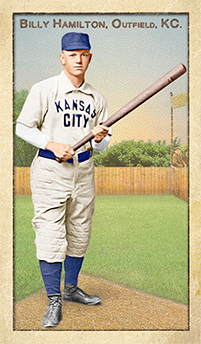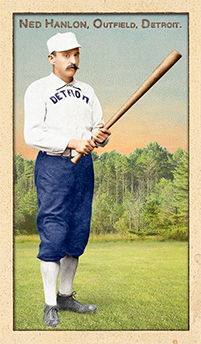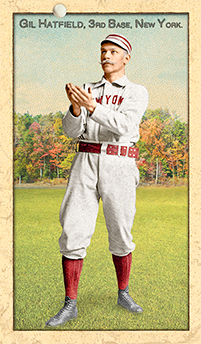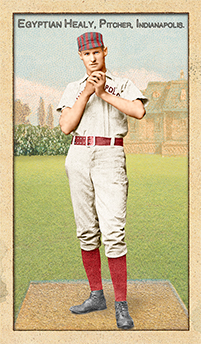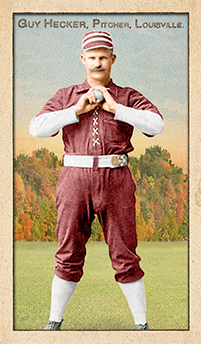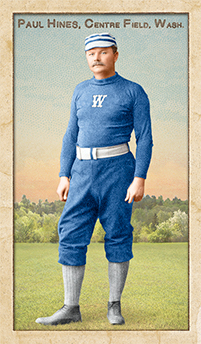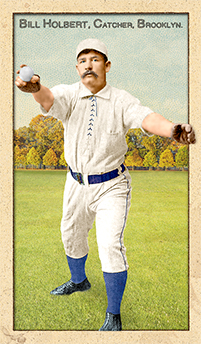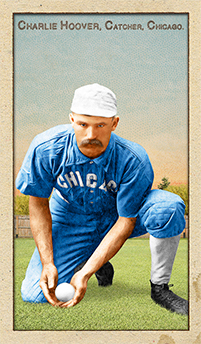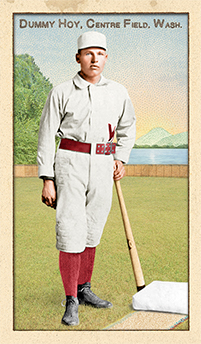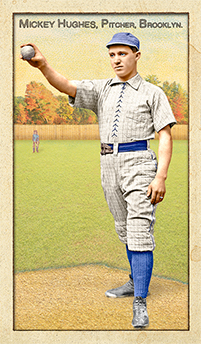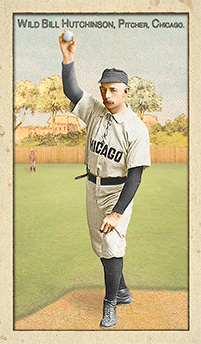
- Series: Beginnings: 1880's
- City: Boston
- Team: Beaneaters
- League: National League
Thomas Francis Gunning (1862-1931) looks like a mediocre ball player on the record. His six years in MLB show a weak hitting catcher whose defense was shaky. The stats belie a “sober, honest, reliable and energetic” player who was a credit to his sport. Popular at every level in which he played, Tom was as serious about his studies as about baseball, which is saying something. Even when he was completing his medical degree at the University of Pennsylvania, and with a bad arm, Gunning played for his school team and for Hartford. His major league tenure began with the Beaneaters in 1884 where he played three seasons before moving on to the two Philadelphia clubs, the Quakers and Athletics. His lifetime .205 average and .887 fielding % don’t begin to express his value to his teams or the esteem of his managers and colleagues. Frequently chosen to fill in as an umpire, Gunning was known for his objectivity, sometimes to the dismay of his teammates during a rowdy and partisan era. He turned down overtures from St. Louis in ’87 to remain in Philadelphia and med school.
- Gunning eschewed protective gear & frequently paid the price
- Was assigned as a rookie to the Massachusetts State Association – a “reserve” league concocted by the Beaneaters to safeguard their youngsters from the Union Association’s depredations
- As a young MD in Fall River, MA, had a role in the inquests into the 1892 Lizzie Borden axe murders case
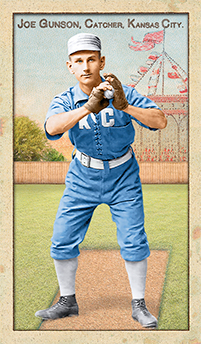
- Series: Beginnings: 1880's
- City: Kansas City
- Team: Blues (WA)
- League: Western Association
Joseph Brook Gunson (1863-1942) was a pioneer catcher in baseball’s early days. Three years before his death, Gunson donated his original mitt to the new Hall of Fame. During his life and since, historians have been as split over who deserves the honor of inventing the catcher’s glove as were the fingers of Gunson and his fellow backstop on the Western League KC Blues. Those torn hands prompted Gunson to contrive some protection. Doc Bushong or Harry Decker may have beaten Joe to the draw, but there can be no argument that this stalwart receiver was a key contributor to the game he loved. Gunson debuted with the lowly Washington club of the upstart Union Association in 1884, then knocked around the minors until catching on with the Browns, Spiders, Orioles and Cowboys during a four-year ML stint.
- Gunson’s stats are unimpressive: a .211 BA, with little power. Yet, like so many early players, he made his mark on the fledgling sport with grit and creativity which laid a foundation for all who were to follow
- The Sporting Life compared Gunson’s hands with their “knots and gnarls” to famed Chicagoan Sylvester “Silver” Flint’s “battered paws.” Such was the catcher’s lot in the 19th century….

- Series: Beginnings: 1880's
- City: Chicago
- Team: White Stockings
- League: National League
Willie Hahm, also known as “Master Willies,” was a rarity among early baseball mascots. He was white. The youngster, said to have been barely able to talk when first brought to the dugout, was the diminutive talisman for the Chicago White Stockings in the mid-1880s. “The Chicagos have great confidence in him as a promoter of success and make a great fuss over him” said Louisville Colonels manager Jim Hart in one of the earliest interviews explicating the curious role of mascots in America’s game. After triumphing in the 1884 campaign, Hart said the Sox had paraded Hahm at the head of their procession in an open landau. The Chicago Tribune reported on a big match with the rival Wolverines on June 18, 1886. Al Spalding brought a trainload of boosters to Detroit in hopes of preventing the eclipse of Chicago’s record home winning streak. Downtown Motor City was treated to the spectacle of the White Stockings and 200 rabid fans marching from the depot to the Russell Hotel carrying broomsticks with Willie Hahm leading the throng. Later, per the Tribune, “The Chicagos were escorted to the ground by a band, and entered the field behind little Willie Hahm, who carried an immense broom on which were written the words Our Mascot.”
- Many of the early mascots were black kids dragooned by superstitious players such as NY’s Buck Ewing
- The first two releases of this card (2016) were errors: Hahm was misspelled as "Hahn"
- Hahm's uniform color in this card was changed from black to blue in March, 2017 to reflect recent reliable research conducted by Craig Brown and friends at Threads of Our Game. Two cards had been previously released featuring a black uniform.

- Series: Beginnings: 1880's
- City: Philadelphia
- Team: Quakers
- League: National League
William Wilson Hallman (1867-1920) enjoyed a fine 14-year career, primarily as a second-baseman. He played mostly in Philadelphia and mostly as a Philly. His best years were 1892-97 where he hit .292, .307, .312, .314, .320, and .262. Versatility and durability were the Hallman hallmarks: he had the ability to help out at any position and played all nine including one game as a pitcher in 1896. Bill set two records a decade apart: leading the American Association in games played in 1891 and the National League in sacrifices in 1901. After ten years in the City of Brotherly Love, Bill found a little less love with the Browns, Bridegrooms and Blues where his average never got to .250. He returned for his final three years back with the Phils. For two years, 1901 and '03, there were two Bill Hallmans in the majors as his nephew, nine years his junior, played outfield in the new American League with Milwaukee and Chicago.
- Over his 14 years in the big leagues, Hallman averaged .272 with a .675 OPS
- Speaking of durability, Bill's baseball life was far from over when he left Philadelphia in '03. He went on to play for ten more clubs in various leagues, retiring at 42
- Hallman's uniform color in this card was changed from black to blue/red in March, 2017 to reflect recent reliable research conducted by Craig Brown and friends at Threads of Our Game. Two cards had been previously released featuring a black uniform.
- Series: Beginnings: 1880's
- City: Kansas City
- Team: Cowboys
- League: American Association
- Hall: National Baseball Hall of Fame
William Robert Hamilton (1866-1940). An outfielder for 3 teams over 14 ML seasons, Sliding Billy was an elite hitter & one of the greatest base runners in history. In 1894, Billy scored a record 198 runs. He ranks 4th all-time in OBP (.455) & 3rd in stolen bases. Billy has a career .344 BA & is 1/3 players to avg 1+ runs scored per game.
- 1 of 5 players to hit a lead-off & walk-off HR in same game
- Was a member of Philly all-.400 outfield in 1894 (.404)
- Elected to Hall of Fame: 1961
- Series: Beginnings: 1880's
- City: Detroit
- Team: Wolverines
- League: National League
- Hall: National Baseball Hall of Fame
Edward Hugh Hanlon (1857-1937). A fast and skilled center fielder over 13 seasons with 6 different teams, Ned made his mark as a manager over 19 seasons. Hanlon compiled a 1313-1164 managerial record & lead his teams through 7 consecutive seasons with .600+ winning percentages.
- 26th all-time in managerial wins
- Hanlon’s “piratical” signing of Lou Bierbauer in 1891 inspired the name Pittsburgh Pirates
- Won 6 NL pennants, 5 as a manager: 1
- Elected to Hall of Fame: 1996
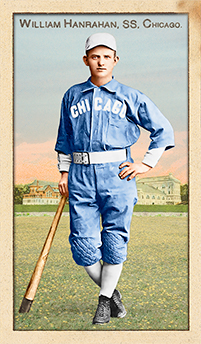
- Series: Beginnings: 1880's
- City: Chicago
- Team: White Stockings
- League: National League
William T. Hanrahan, nicknamed “Red,” played minor league ball from 1885 through 1898, primarily in the Western Association and the Eastern League. He began with Albany of the New York State League but moved west to Chicago in 1888, presumably to make his bid to play major league baseball in the National League.
The shortstop was photographed by Old Judge that year in a Chicago White Stockings uniform. However, Red never played for the team and is identified by Goodwin instead as a member of the Chicago Maroons in 1888 and the Minneapolis Millers in 1889. This makes Red one of a handful of Old Judge subjects who was lucky enough to be on a major league roster the day the Goodwin photographers showed up, but unlucky enough to be removed from the roster without ever having played a game for that or any other major league team. So close, Red! So close.
Red was a regular with both the Maroons and Millers, playing in over a hundred games for both clubs. The sketchy minor league stats don’t record every campaign, but he seems to have generally batted under .300, faring better in the 1890s when he returned east. He hit .307 with Albany in ‘93 and .306 with Rochester in ‘96. By then his plate appearances were in decline, getting into only 16 games with the Browns. Red’s final season brought his pro ball career full-circle as he wrapped it up with the Johnstown/Palmyra Mormans (aka Johnnies) of a newly reconstituted NY State League in 1898, which now included Pennsylvania teams.
- The Maroons and Millers were led by manager Moxie Hengel, the only two seasons he managed in pro ball. With Minneapolis, Moxie shared managerial duties with Sam Morton. It is said the two had a strange method, Hengel piloting the road games and Morton serving as the home field boss
- As a rule of thumb in the 1880s series, I always designate a player’s team as that for which he is uniformed in the photograph, even if he never played for the team.
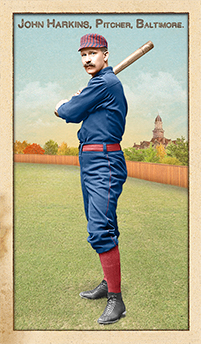
- Series: Beginnings: 1880's
- City: Baltimore
- Team: Orioles
- League: American Association
John Joseph Harkins (1859-1940) came by his nickname “Pa” early in his career but really earned it after his ninth son was born in 1911. Harkins was a pitcher for the Cleveland Blues, Brooklyn Grays and Baltimore Orioles from 1884-88, establishing a so-so record (51-83 with a 4.09 ERA). The stats tell only a small part of Pa’s story. A half century later, his obituaries in hometown New Brunswick, NJ would extol an esteemed citizen, father, coach and, yes, “one of the last surviving big-time baseball players of the Eighties.” He was hailed as half of the “famed battery” with Cleveland: Harkins and Bushong “which thrilled fans in 1884.” Harkins was the first major-leaguer to come out of Rutgers and went on to coach at Yale, Lehigh and Princeton. He mentored the future football legend Amos Alonzo Stagg who remained a lifelong friend. The Blues folded after Pa’s ’84 season and seven players migrated to Brooklyn including catcher Doc Bushong. Harkins was a regular starter for his three years there, got into only one game for the Orioles in ’88 and went into college coaching.
- Back home, Harkins went into business with a tavern, served in public office and as a court official
- John was the Grays’ opening day starter in 1885 and 1886
- Harkins' uniform color on this card was changed in June, 2017 from black/red to blue/red to reflect recent reliable research by Craig Brown & friends at Threads of Our Game. Six cards were previously released featuring a black uniform.
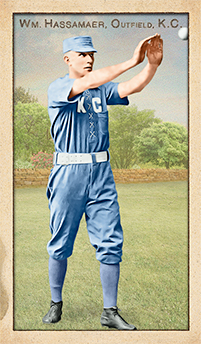
- Series: Beginnings: 1880's
- City: Kansas City
- Team: Blues (WA)
- League: Western Association
William Louis Hassamaer (1864-1910) played outfield for three seasons in the National League. His rookie campaign was with the Senators in 1894, the team he would start the ‘95 season with before being sent to Louisville, where he would finish his ML career a year later. Bill made a splash in his first year in the big leagues. On June 13, 1894 he became the 30th ML player to hit for the cycle, in a game against the St. Louis Brown Stockings. The feat had actually been accomplished 36 times previously. Curry Foley recorded the first cycle in 1882 (some sources cite a 1st cycle by George Hall in 1876); Long John Reilly recorded three cycles with the Reds between their stints in both the AA & NL (his first two cycles were only seven days apart); and Dave Orr, Tip O'Neil, Pete Browning & Mike Tiernan had each recorded two cycles by the time Hassamaer earned his membership to the elite club.
Hassamaer’s debut was auspicious in every sense that rookie year. He hit .322 with four homers and 90 RBI. He showed some speed as well, stealing 16 bases. Unfortunately, Hassamaer’s performance would steadily decline thereafter. He never again attained any of the offensive output of that first season. His second year with Washington saw his average drop to .278 with a tail-off in every category. He was purchased by Louisville for $200 on August 23, 1895. The move to Kentucky only sent Bill’s record into a deeper spiral. He batted a mere .208 for the 23 games he played at the end of the ‘95 season. Despite this meager accomplishment, the Colonels gave Hassamaer another shot in ‘96, but his .245 average with little power proved too little and he was released after only 30 games.
Prior to joining the National League, Bill had a successful tenure in the minors. He had begun in 1887 with the Western League’s Kansas City Cowboys, playing full time and hitting .371. After a second year in KC, he bounced around a number of teams and his average fluctuated wildly. His efforts for the Montgomery Colts of the Southern Association in 1893 paved the way for his major league call-up when he hit .321.
- Hassamaer’s swan song came with the Bridgeport Orators of the Connecticut League in 1899 where he played for the club’s namesake and manager, Jim “The Orator” O’Rourke. O’Rourke had enjoyed one of the finest playing careers in the early game and was inducted into the Hall of Fame in 1945
- Series: Beginnings: 1880's
- City: New York
- Team: Giants
- League: National League
Gilbert Hatfield (1855-1921). A pitcher and infielder for 6 teams over 8 seasons, Hatfield did not break into the majors until the age of 30 – then played sporadically across the next decade – actually getting into 5 games with Louisville at the age of 40.
Hatfield was a member of the 1888 World Series Champion New York Giants. As a hitter, Hatfield went 2-8 in the series with 1 BB, 1 RBI & 1 Run. As a pitcher, Hatfield made 1 relief appearance, giving up 12 hits & 12 runs (7 earned) in 5 innings.
- Series: Beginnings: 1880's
- City: Indianapolis
- Team: Hoosiers (NL)
- League: National League
John J. Healy (1866-1899) hailed from Cairo, IL and was also nicknamed “Long John” for his slender 6’2” frame. He began in pro ball with the St. Louis Maroons, the only close-to-ML-quality team in the Union Association’s only season. His career was marked by being the best pitcher on poor teams, including the AA’s Toledo Maumees and the Indianapolis Hoosiers.
- The “ace” of the Hoosiers in ’87 with a 12-29 record, most losses in the NL
- Recognized by Albert Spalding for his talent, joined the “world tour” of 1888-89
- Series: Beginnings: 1880's
- City: Louisville
- Team: Colonels
- League: American Association
Guy Jackson Hecker (1856-1938) went 6 for 6 in one game, hit 3 HRs in another, and won the AA batting title in 1886. He also pitched a no-hitter. His WHIP wasn’t eclipsed until Pedro Martinez edged out his mark in 2000. In ’84 Hecker was the triple-crown winner with 52 wins, 385 SOs and a 1.85 ERA. Small wonder he is regarded as the best pitcher-hitter of the 19th Century.
- Played almost exclusively for Louisville, finishing his career in 1890 with the Alleghenys
- Lifetime 2.92 ERA, 1,100 strikeouts, and a record of 175-146
- Guy’s uniform color on this card was changed in February, 2017 from black to maroon to reflect recent reliable research by Craig Brown & friends at Threads of Our Game. Nine cards had been previously released featuring a black uniform.

- Series: Beginnings: 1880's
- City: Pittsburgh
- Team: Alleghenys
- League: National League
James Harding Henderson (1862-1903) could have been nicknamed “Hard-Luck” Henderson instead of Hardie. He is one of only 34 pitchers of the 1870s and 1880s to achieve 200+ decisions. Unfortunately, most were losses (81-121 over his six-year major league career with four teams). Hardie came up with the NL’s Quakers in 1883 and was rudely treated in his debut by the Providence Grays and one Charles Radbourn. Old Hoss made Hardie one of the 48 notches on his belt that year, prepping for the glory of “59 in ‘84." Philadelphia soon shuffled Henderson off to Baltimore where he would achieve ignominy in a number of categories: most losses in ‘85 with 35; most walks in ‘84; most hits, walks and runs surrendered in ‘85; not to mention twice leading the league in wild pitches. Nevertheless, the guy won 81 games in a mere six seasons and compiled a lifetime 3.50 ERA, so the losses couldn’t have all been his fault.
- In a curious bit of morbid irony, the Library of Congress lists Hardie Henderson as a member of the Brooklyn Trolley-Dodgers - for his 1888 Kimball Campions (N184) card - when the team was actually known as the Grays. The borough of Brooklyn wouldn’t be known by that Manhattan put-down until 1895 - the year the team adopted the Trolley-Dodger nickname. Unfortunately for this man who has been posthumously misidentified as a trolley-dodger, Hardie perished under the wheels of a Philadelphia trolley while making his way home from work at a pool hall at the tender age of 40
- Henderson's uniform color in this card was changed from black & red to blue & red in March, 2017 to reflect recent reliable research conducted by Craig Brown and friends at Threads of Our Game. Two cards had been previously released featuring a black uniform.
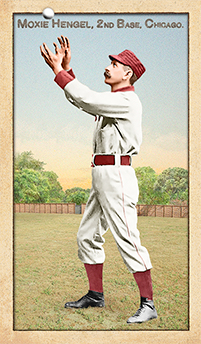
- Series: Beginnings: 1880's
- City: Chicago
- Team: Maroons
- League: Western Association
Emery J. Hengel (1857-1924) had brief stints in major league baseball during parts of the 1884 and 1885 seasons. Moxie signed on as an infielder with his hometown's entry in the upstart Union Association, whose Browns sought to compete with the renowned Chicago White Stockings. The experiment failed and, by August, the club had moved to Pittsburgh (as the Stogies) and lasted until September 18. Many of the players went to Baltimore's Monumentals, but Hengel landed in the Twin Cities with the St. Paul Saints (White Caps). That franchise's contribution to the UA amounted to eight games in total, all on the road. Moxie's anemic .152 average might have signaled a quick end to his would-be career, but he got one more chance - this time with the National League's Buffalo Bisons in what would be their final campaign in the majors. That 1885 season saw Hengel teaming with some real stars: first baseman Dan Brouthers, second baseman Davy Force, shortstop Jack Rowe, third baseman Deacon White, outfielder Hardy Richardson and pitcher-manager Pud Galvin were all on hand. Despite all that talent, the Bisons ended the year ahead of only the woeful St. Louis Maroons and were folded into the Detroit Wolverine club the following season. By this time, Moxie had achieved the dubious distinction of having been on the final rosters of four straight failed ball clubs within two years - and Moxie's days in the Show were over. Undeterred, Hengel returned to the minors, playing for the Utica Pent-Ups, Chicago Maroons, Minneapolis Millers and others before closing his pro tenure with the Minneapolis Minnies of the Western League in 1894 at age 36. In '92 Moxie made a stop in Michigan with the Ishpeming-Negaunee Unions of the Wisconsin-Michigan League, a team that, thankfully, never had to recruit a radio broadcaster.
- Moxie's first major league manager was Ed Hengel. One of three managers for the Chicago Browns in 1884, Ed managed the team to 34 wins and 39 losses. Ed was also born in Chicago and just two years before Moxie. While it's hard to imagine the two were not related, research has not revealed any familial connection.
- Moxie's batting average for his three big league teams was .180. He hit no home runs but did manage three doubles and two triples in his 35 games
- Moxie may have been a better leader than ballplayer: He managed the Chicago Maroons in 1888 and the Minneapolis Millers (road games only) in 1889
- The first release of this card (January, 2017) was likely an error: Hengel was misspelled as "Hengle." This is actually a common mistake for Moxie and it has caused a fair amount of confusion through the years. The Old Judge editors spelled his name "Hengle" and his Wikipedia entry uses the two spellings interchangeably. Deeper research indicates that "Hengel" is the most likely spelling. All subsequent releases of this card will feature the name "Hengel."

- Series: Beginnings: 1880's
- City: Philadelphia
- Team: Quakers
- League: National League
John Michael Henry (1863-1939) was a pitcher and outfielder with 4 major league teams for 4 seasons between 1884 & 1890. He compiled an overall .243 batting average in 218 at bats. He was 4-14 on the mound with a 4.09 ERA, one shut-out and 18 complete games. Henry began his time in the big leagues with the Cleveland Blues in the franchise’s final year. In ’85 Henry moved to the Orioles where he was part of a large supporting cast to the club’s ace, Hardie Henderson who recorded 60 decisions. The following year found Henry in D.C. with the cellar-dwelling Washington Nationals who played at the Swampoodle Grounds where their surroundings were as murky as their prospects. Henry’s swan song came with the NY Giants in ’90 where he played little as Amos Rusie and Jesse Burkett dominated the roster.
- Henry came to the major leagues in good company. He was sold by Hartford of the Eastern League to Washington with Connie Mack and three others for $3500
- A native of Springfield MA, Henry was interred at Mount St Benedict Cemetery, Bloomfield CT
- Henry’s uniform color on this card was changed in June, 2017 from black/red to blue/red to reflect recent reliable research by Craig Brown & friends at Threads of Our Game. Six cards were previously released featuring a black uniform.
- Series: Beginnings: 1880's
- City: Washington, D.C.
- Team: Nationals
- League: National League
Paul Aloysius Hines (1855-1935). A hearing-impaired center fielder for 16 professional seasons, Hines accumulated the most hits in the first 5 years of National League history and, upon his retirement in 1891, was 3rd all-time in hits behind Cap Anson & Jim O’Rourke.
- Won baseball’s 1st Triple Crown: 1878
- May have recorded the 1st unassisted triple-play in history
- Twice won the batting title
- Hines' uniform color in this card was changed from black to blue in May, 2017 to reflect recent reliable research conducted by Craig Brown and friends at Threads of Our Game. Nine cards had been previously released featuring a black uniform.

- Series: Beginnings: 1880's
- City: St. Louis
- Team: Whites (WA)
- League: Western Association
Henry Fred Hines (1867-1928) was a fireplug of an outfielder. While his major league experience was ever so brief - two games with the Brooklyn Bridegrooms in 1895 - Hines enjoyed a long career in professional baseball. He began as a teenager in 1887 with the Milwaukee Cream Cities, getting into a mere nine games, but that humble beginning launched him into a 19-season career that didn’t end until 1910 when Hunkey played for and managed the Joliet Jolly-ites/Sterling Infants of the Northern Association. By the time Hunkey became an "Infant," he was 42 years old. The available data show that Hines’ career batting average was .250, precisely what he achieved in those two games in Brooklyn where he got two hits and walked twice in two games. The Illinois native spent most of his minor league time in the greater midwest, but he did venture as far west as the Bay Area’s Oakland Oaks in 1891 and ‘93. He played two seasons for the Detroit Tigers when they were in the Western League, 1900-01. In 1906 Hines was in the deep south playing for the Baton Rouge Cajuns, evidence that baseball afforded the sturdy Hunkey a tour of much of the continent.
- Hines’ best year at the plate was a startling .427 for the Minneapolis Minnies in 1894. This wasn’t a fluke. Hunkey had 586 at bats that career-year when he also clubbed 34 home runs. He never hit more than six in any other season of his long career
- Series: Beginnings: 1880's
- City: Brooklyn
- Team: Bridegrooms
- League: American Association
William Henry Holbert (1855-1935). Holbert was a catcher for 6 teams over 12 seasons and is perhaps best known as the player with the most career at bats without a home run (2,335). While a good defender, Bill was a weak hitter compiling a career BA of .208, with .228 OBP, .232 SLG, and an OPS+ of 47.
- One of the original umpires of the Player’s League in 1890
- Of his 486 hits, only 48 were for extra bases

- Series: Beginnings: 1880's
- City: Des Moines
- Team: Prohibitionists
- League: Western Association
James Wear Holliday (1867-1910) had a knack for beginnings. He began in big league baseball at its pinnacle: game five of the 1885 post-season series. He wouldn’t play in a regular-season game until 1889, but again reached an apex by leading the league in home runs as a rookie. Bug’s sophomore season began with another bang: an opening game HR. Holliday played exclusively for Cincinnati and during his six prime years was second only to Roger Connor in home runs. His peak productivity came in 1894 when he hit .372, scoring and driving in 119 runs. Thereafter, health took a sad toll. Following an appendectomy in ‘95 Bug was never the same and his life ended too early due to a fatal infection.
- At 5’11” “Bug” was not tiny, but he struck some as such way out in center field and got the nickname
- His unlikely debut came about when Cap Anson was desperate for a right-fielder in the St. Louis Series. Young Bug fared poorly and headed to the minors for seasoning.
- Holliday’s uniform color on this card was changed in June, 2017 from black to blue to reflect recent reliable research by Craig Brown & friends at Threads of Our Game. Six cards were previously released featuring a black uniform.

- Series: Beginnings: 1880's
- City: Philadelphia
- Team: Quakers
- League: National League
William James Hoover (1863-1924) was a prime example of players from the beginning of baseball who could shine at the amateur or minor league level and fail when up against the true elites of the game. In Buster’s case, the exception (the Union Association of 1884) proves the rule. That is where Hoover began in the “majors” but was really playing against minor-league caliber opponents. He wowed, hitting .364 (2nd in the league), third in OBP and slugging. Then that quixotic misadventure ended and the players had to find real homes. Buster’s was still in Philadelphia with Harry Wright’s Quakers where he hit .190. After years mostly in the minors (where he often excelled, averaging .306 over 11 seasons) he got a shot with the Orioles and hit .217. Finally, the Cincinnati Reds gave him a try in 1892: 14 games, .176. Hoover finished up hitting .305 for the Troy Washerwomen in 1894.
- Bill James has thoroughly analyzed the quality of the Union Association and found that it, like the anonymous Wisconsin dairy, could have embraced the motto: “Our Best Is None Too Good”
- Hoover’s uniform color on this card was changed in June, 2017 from black to blue/red to reflect recent reliable research by Craig Brown & friends at Threads of Our Game. Five cards were previously released featuring a black uniform.
- Series: Beginnings: 1880's
- City: Chicago
- Team: White Stockings
- League: National League
Charles E. Hoover (1865-?) was a catcher for the Kansas City Cowboys of the American Association from the end of the 1888 season through the following year. Hoover was a teammate of the franchise’s only Hall of Famer, “Slidin” Billy Hamilton. As an end-of-season rookie, Hoover appeared in only three games in ’88 but went 3 for 10. The following year he was in 71 games, mostly behind the plate but with turns at third base and the outfield. He hit .248 with 25 RBI. Hoover also had an extensive minor league career including such colorful teams as the Des Moines Prohibitionists, the Davenport Onion Weeders and the Lincoln Rustlers.
- All in all, Hoover was on the roster of 12 minor league squads, literally from coast to coast (from the Savannah Modocs to the Sacramento Senators)
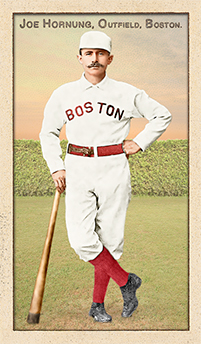
- Series: Beginnings: 1880's
- City: Boston
- Team: Beaneaters
- League: National League
Michael Joseph Hornung (1857-1931) made a lasting impression in the baseball world of his day on at least two grounds. Most noteworthy, he was perhaps the premier defensive outfielder of the 1880s. His sure-handedness allowed him to lead the National League in fielding percentage in 1881, ‘82, ‘83 and ‘86. The second basis of notoriety for Hornung was what must have been a very annoying habit. He would shout “ubbo, ubbo!” whenever he got a hit or made a play he fancied. Since he hit a respectable .257 over his twelve-year career, and made just about all the plays that came his way in the no-glove era, the ballparks of the day must have resounded with many an “ubbo.” His antics led to his nickname Ubbo Ubbo, which meant others beside himself were uttering the gibberish all too frequently.
Joe had begun his pro career in Canada with the London (Ontario) Tecumsehs in 1876. His major league debut was with the Buffalo Bisons in 1879 and in '81 made the move to Boston which would be his home through the 1888 season. The colorful star's performance declined and the Beaneaters tried to sell him to the White Stockings. The veteran balked, insisting on a piece of the $5000 price, and was rewarded by being ousted from the league. The American Association's Orioles welcomed Joe and he played one year on a bad leg before ending his big league career in 1890 with the Giants. His speed had been an asset afield and on the bases. Hornung was a renowned base-stealer, usually among the leaders in triples, and led the NL in scoring in 1883.
- Ubbo Ubbo's popularity was such that the vaunted '27 Yankees honored him on his June 12 birthday at the stadium. Ruth, Gehrig, Lazzeri and all serenaded Joe and he received a “nice check” from players who remembered him fondly as one of the greats.
- His hometown Utica paper hailed him as “King of the Left Fielders” and “just as much a baseball hero as Ty Cobb, Babe Ruth or Tris Speaker is today.”
- Series: Beginnings: 1880's
- City: Washington, D.C.
- Team: Nationals
- League: National League
William Ellsworth Hoy (1862-1961) was a renowned outfielder for the Cincinnati Reds & other clubs over a 15 year career. Hoy was rendered deaf by a childhood illness. He was not the 1st deaf player in the majors, but he was the most accomplished, using his speed and small stature (5’4”) to generate walks and steals. Hoy retired in 1902 holding the career record for outfield chances.
- Hoy’s record three outfield assists to the plate in one game were all to his catcher Connie Mack
- At his death in 1961 he was the longest lived major league player at 99 years of age
- Hoy's uniform color on this card was changed in June, 2017 from blue to red to reflect recent reliable research by Craig Brown & friends at Threads of Our Game. Nine cards were previously released featuring a blue uniform.
- Series: Beginnings: 1880's
- City: Brooklyn
- Team: Bridegrooms
- League: American Association
Michael J. Hughes (1866-1931) got 25 of his three-year career total 39 wins for the Brooklyn Bridegrooms in his rookie season, 1888. That performance earned Hughes the opening day start for Brooklyn in 1889, but he fell to a lackluster 9-8 record that year. Hughes was traded to the Athletics in 1890, finishing his brief ML tenure going 1-3 in six games.
- In Brooklyn’s final year in the American Association, Hughes went 1-0 in the 1889 Series against the NY Giants, won by NY 6 games to 3
- Series: Beginnings: 1880's
- City: Chicago
- Team: White Stockings
- League: National League
William Forrest Hutchinson (1859-1926) played primarily for Chicago over his 9 seasons and still ranks high in Cub franchise history in several pitching categories. He is tops in complete games with 317 and 2nd in innings pitched. He was the 1890 NL saves champion and league champ in wins three times.
- Played 2 games with KC Unions in ’84, then labored in minors until signing with Chicago in ‘89
- Regarded by many as the “biggest casualty” of the new mound distance in 1893
- A Yale grad in 1880, Hutchinson was one of the first in MLB to earn a BA




